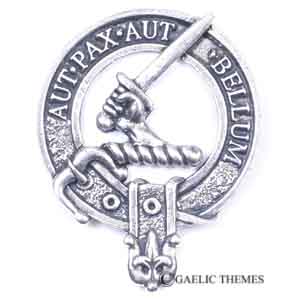Gunn
Select
- Design: Standard
- Clan Motto: Aut Pax Aut Bellum (Either peace or war)
- Notes:
Crest: A dexter cubit arm attired in the proper tartan of Clan Gunn, the hand Proper grasping a basket-hilted sword blade Gules, hilted Argent
The name Gunni translates “war” in Old Norse and Gunni, the progenitor of the clan, was the descendant of Vikings. His grandfather, Sweyn, had been killed while raiding Dublin in 1171. Gunni came to Caithness with his wife, Ragnhild, at the end of the twelfth century. A descendant of St. Ragnvald, she had inherited lands from her brother, Harald, Jarl of Orkney.
The first chief of Clan Gunn to appear in common records was George Gunn, who was coroner of Caithness in the fifteenth century. The proper patronymic of the chiefs was ‘MacSheumais Chataich’. However, George was commonly called ‘Am Braisdeach Mor’ -- “wearer of the great brooch” which referred to his badge of office as coroner.
The Gunns were blood enemies of the Keiths, who using their castle at Ackergill as a base, encroached on Gunn lands as well as hegemony in the region. The initial cause of the feud was an incident where Dugald Keith kidnapped the daughter of Gunn of Braemor and took her to Ackergill. Rather than submit, the girl threw herself from the castle wall.
The Gunns raided Keith territory often, but with little success. The two sides finally met in what was supposed to be a battle of champions -- each clan agreed to bring twelve horse to the field. However, the Keiths carried two warriors on each horse. Outnumbered, the Gunns were slaughtered. The chief was killed along with four of his sons and the great brooch was stolen.
The chief's surviving son, James, eventually avenged the family by killing Keith of Ackergill and his son. However, the troubles continued when sometime around 1586 the earls of Caithness and Sutherland entered a pact to destroy Clan Gunn. To shore up defensive alliances, Gunn of Killearnan married Mary, sister of Lord Reay, chief of the Mackays. The next Gunn chief married Lord Reay’s daughter. The son from this marriage was Donald Crottach (‘the hunchback’), sixth chief. During Donald’s time, Killearnan house was destroyed accidentally by fire and the lands were lost to debt.
Another branch of the Gunns fared better. The Gunns of Braemore were descended from the first chief through his son Robert and were known as the Robert Gunns. Sir William Gunn of this line earned fame commanding a battalion for the king of Sweden. Later, he fought for Charles I, who knighted him in 1639. William eventually returned to the continent and married a German baroness, became an imperial general, and was made a baron of the Holy Roman Empire in 1649.
At the end of the eighteenth century, the Gunns of Braemore had to sell their estates due to debts, but the Gunns of Killearnan gained a new estate at Badenloch. The Gunns supported the Hanoverian crown during the Jacobite uprisings. The eighth chief served as a regular highland officer and was killed in India. The chiefship passed to a cousin and remained in his line until the tenth chief died without an heir. The clan is presently led by a commander, a descendant of a seventeenth century Caithness laird.
